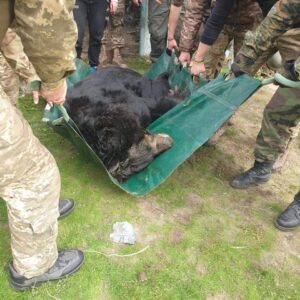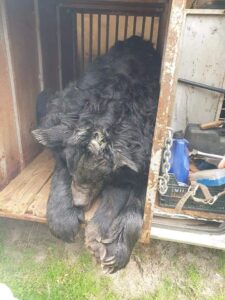Peering into a metal enclosure, a team of Ukrainian military and animal rights activists spotted a black bear lying on a concrete floor. Its curved black claws rested on the ground next to its head. The volunteers quickly realized the bear had suffered a traumatic brain injury from nearby bombing. The bear had been left locked in an enclosure alone, without adequate food or water, and was severely injured. Even before the bombing, the zoo animals had been abandoned without proper care. This is the reality faced by thousands of animals in Ukraine since the war began over a year ago.

The bear was found injured, alone, and without food or water.
On February 24, 2022, Russian forces invaded Ukraine. In the following months, millions of people were displaced as they were forced to escape to another region, and millions more fled the country entirely. According to The Office of the United Nations High Commissioner for Human Rights (OHCHR), more than 7,000 civilians have been killed, and more than 11,000 have been injured since the beginning of the war. In the past year, approximately 18 million border crossings have been reported.
While the human citizens of Ukraine face extraordinary hardship, their beloved animals do, too. Many families opted to stay in their homes because of their pets, but others left without them. Evacuating families surrendered their pets to shelters—but they too are not safe from the devastation of war. In April, more than 300 dogs died after weeks of no food or water after volunteers were unable to access the building due to relentless Russian attacks. The suffering and death of animals is yet another horrible layer of the war that has torn apart the lives of so many.
Animal deaths as a result of war often go unrecorded in official casualty numbers, but that doesn’t mean they are being overlooked: Many organizations in Ukraine and abroad are extending their love beyond human citizens and working diligently to help.
Some Ukrainian shelters are coordinating with organizations in the U.S. to provide animals with the care they need. Homeward Trails Rescue, a non-profit group located in Arlington, Virginia, has rescued thirty cats directly from Ukraine. In their first trip in April–May 2022, volunteers worked to establish a new shelter. Shana Aufenkamp, a short-term volunteer, fed animals, gave medication, and cleaned their living quarters. Socialization was also a huge aspect of animal care as they were moved into a group environment. Many cats were terrified and struggling to adjust, so showing them love and care was crucial to their well-being. As a fluent Russian speaker, Shana also assisted with translations during their trips.
Their second trip, in October, lasted two weeks. It was spent caring for cats and completing the required paperwork to bring them home. Shana explained that most of the cats were surrendered by families who knew that they would soon be unable to care for them due to lack of reliable housing. Others came from shelters in Ukraine that were destroyed or forced to close. Once returning to Virginia with the cats, the adoption process continued.
Some cats were moved to foster homes to be observed for any stress- or travel-related health problems. Other cats were relocated to a more social setting: a cat café. Homeward Trails works with a café in Georgetown, Washington D.C., called Crumbs and Whiskers. Since many of the cats from Ukraine came from nurturing families, they did well in a more communal environment where they could be showered with kindness and care on a daily basis. The welcoming, loving space allowed them to acclimate, while also providing an opportunity for potential adopters to meet them.
“As we bring back kitties from Ukraine,” Shana said in a Zoom interview, “it’s been interesting to see that many are adopted by families with ties to Ukraine.”

Shana Aufenkamp, a volunteer from Homeward Trails Rescue, holding Gizmo the cat during a Zoom interview.

Gizmo is a special-needs Scottish Fold kitty from Ukraine.
She has seen a definite connection between the rescued animals and their adopters, especially Ukrainian Americans and individuals with close friends or relatives in Ukraine. Shelter workers have observed an emotional connection—individuals speaking to the rescued cats in Ukrainian, and feeling like they are helping to support Ukraine in a meaningful way by caring for the pets of someone who was unable to keep them.
Shana also found it meaningful to see the difference in environment for the cats. Many of them came from unsettled group settings in war-torn cities, and now, “they’re living in fancy apartments in D.C. with heated floors.”
One cat placed by Homeward Trails is Paddington, who lived in a shelter in Central Ukraine for months after losing his home. Separated from his family and moved to a chaotic environment, Paddington fell ill. He still experiences health issues today—he has a heart murmur and follows a strict kidney-friendly prescription diet. Since moving in with his foster family in the U.S., he has been classified as a “stage 5 clinger” and “[worker] at the biscuit factory.” His loving personality now has room to shine.
In addition to their trips to Ukraine, Homeward Trails collaborates with other organizations internationally, such as Breaking The Chains, which was originally founded by British Army veteran Tom S-N as a media company geared toward animal advocacy groups. After the start of the conflict in Ukraine, the group evolved into a first-response animal rescue team.
Animals in Captivity
While many organizations focus on companion animals, animals in captivity are also deeply impacted by war. There are three large zoos (Nikolaev Zoo, Kyiv Zoological Park, and Kharkiv Zoo) and several privately-owned zoos in areas under Russian invasion. These animals are subject to military attacks, abandonment, or both. While many families and shelters are working to accommodate pets, it’s immensely more difficult to manage the care of wild animals. Kyiv Zoo struggled to protect their 4,000 animals—but could not evacuate them without adequate veterinary care and transportation. Many animals experienced mental distress, and some were even given sedatives to cope with the noise from incoming attacks.
Breaking the Chains ventured from Bulgaria to Ukraine with the intention of saving as many creatures as possible. Their team quickly grew, and they were able to extract more than 5,500 animals, including “dogs, cats, horses, foxes, birds, ferrets, goats, pigs, donkeys, a wolf, Europe’s largest bear, and a pride of nine lions—the largest big cat extraction from an active warzone.”
In May 2022, the owners of privately-owned Bio Park Zoo in Odessa were concerned about being unable to care for their lions, as their food alone would require at least $2,500 each month. The other main concern was imminent Russian attacks: Aside from the animals being injured or killed, some people were also concerned that the lions would escape if their enclosures were damaged. A group of 13 volunteers from multiple rescue teams came together to relocate the lions, plus two cubs.
After sedating the lions, the rescue team loaded the animals into crates for the journey. They transported them in four vehicles across three countries, amounting to more than 600 miles. Two of the lions, Simba and Mir, will find their forever home in Simbonga Game Reserve and Sanctuary, located in Eastern Cape, South Africa. The other seven lions (plus two cubs) were airlifted to Dallas, Texas, before being driven to Colorado. The lions now live in The Wild Animal Sanctuary, where they have over 10,000 acres to roam. The sanctuary’s goal is to allow rescued animals to live freely “where they can experience life with plenty of space, diets of exceptional quality, expert veterinary care, and freedom from performing, traveling, or doing anything unnatural.” Despite their arduous journey, the lions are now free from the small, concrete confines of the zoo. The devastating conflict in Ukraine essentially drove these “big cats” to a healthier and more natural habitat.
Lions aren’t the only large animals in need of support: remember the black bear that narrowly survived a bombing? In October 2022, the concussed black bear was rescued from the Donetsk region after the Ukrainian military and animal rights activists found it lying on the cold floor of an enclosure. Like the pride of lions, the bear had lived in a private zoo—until it was hit by shelling during Russian occupation. Everything within three meters of the enclosure was destroyed. Rescuers say that Russian forces cruelly treated the animals in the zoo, but The Armed Forces of Ukraine discovered the surviving bear still locked in its cage after the region was liberated. George Packer writes in The Atlantic, “The Russians have identified yet another way to inflict pain on the Ukrainian people—not by starving them, but by breaking their heart.” Some have even accused Russian forces of targeting rescue groups and adoption centers. Animals that survive these attacks are left in freezing conditions with only the remnants of food left by volunteers, and water dishes that quickly turn to ice.
An adult black bear can weigh up to 500 pounds, which is nearly the weight of a baby grand piano. Imagine helping to lift such a massive, unconscious creature in the midst of a war zone. The bear was moved onto a tarp, and eight individuals held tightly to handles along the sides to lift it. Once hoisting the bear into their vehicle, the team headed to a wildlife center near Kyiv—a journey of more than 400 miles, or approximately nine hours of driving. When his condition improves, he will be moved to Arden Predator Park in the Khmelnytsky region. Arden Predator Park is a rehabilitation center designed to “preserve animal populations, rescue [animals] from captivity, and adapt them to [life] in the wild,” with a focus on eco-education. The park operates differently from zoos, allowing the public to observe recovering animals from a distance with minimal interference.


Before going to Arden Predator Park, the bear will temporarily stay at a center operated by rescuer Natalia Popova and animal protection group UAnimals. Ukrainian soldiers alert Popova when animals in the battle zones are in need of care, and she does her best to save them. “No one wants to go there. Everyone is afraid. I am also scared,” she said in an interview with New York Post. “But, I go anyway.” Popova coordinates with animal sanctuaries around the world to ensure that animals end up in a safe place.
Regardless of physical location, anyone can help in some capacity. Animals from Ukraine are in need of supportive families in several countries. Aside from directly caring for animals, it’s possible to support them from a distance. Many rescue organizations rely on donations. We cannot overlook the non-human victims of war, and change is most possible through combined effort. “It really is the network of animal lovers working together that makes it all possible,” Shana said.
Support/Donation Links
- Homeward Trails Rescue: homewardtrails.org/help-out/donate-money/#.Y_LXVMfMK3A
- Breaking The Chains: breakingthechainsinternational.org/donations
- Paws of War: pawsofwar.networkforgood.com/projects/156274-help-save-the-people-pets-of-ukraine
- Kherson Cat Begemot (a shelter that Shana personally supports): facebook.com/profile.php?id=100009186110274
Get more like this—Sign up for our daily inspirational newsletter for exclusive content!
__
Photo: UAnimals via Facebook; Shana Aufenkamp of Homeward Trails Rescue; Cassidy Klingman




